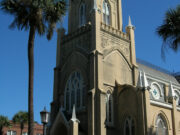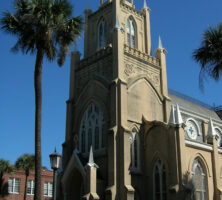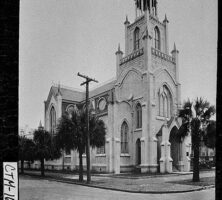Congregation Mickve Israel in Savannah is America’s third-oldest Jewish congregation, and the oldest Jewish congregation in the South. The founders of the congregation, comprising the largest group of Jews to settle in North America during the colonial period, arrived in Savannah in July 1733 aboard the William and Sarah.
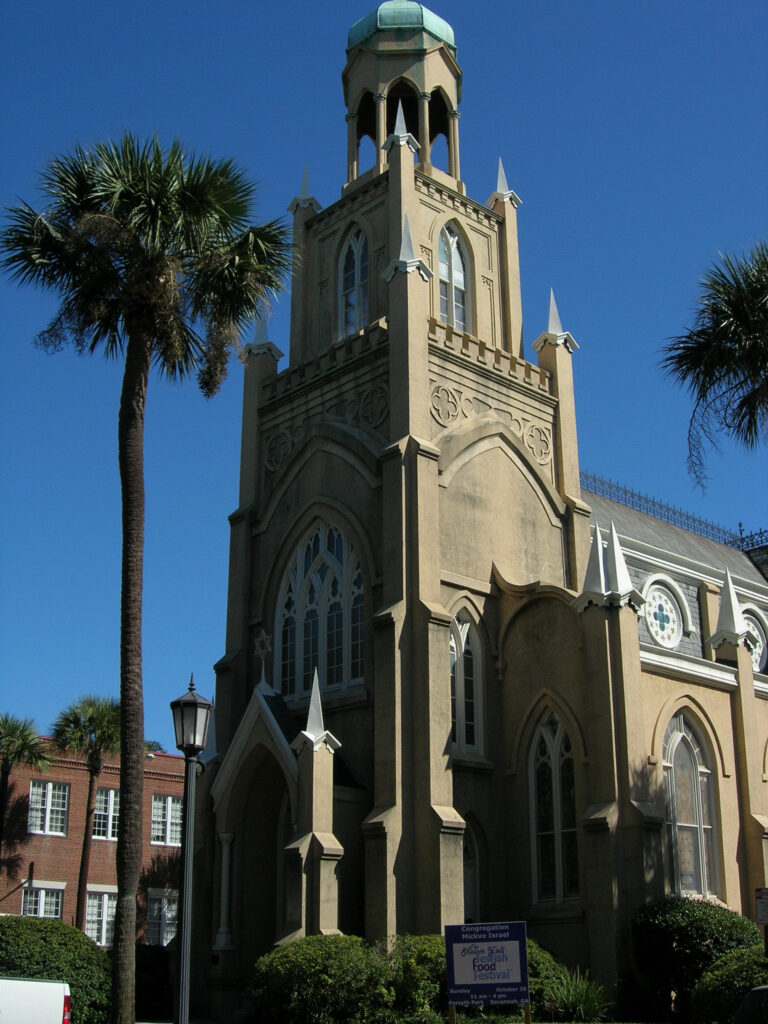
Photograph by Kelly Caudle, New Georgia Encyclopedia
Creation of the Congregation
On July 11, 1733 the William and Sarah landed near Savannah. Of the forty-one passengers who arrived in Georgia, thirty-four were Sephardic Jews (Jews of Spanish and Portuguese heritage). The remainder were Ashkenazic Jews of German descent. The venture had been funded by affluent members of the London Jewish community in order to assist impoverished Jews in immigrating.
The vast majority of the Jewish colonists had survived the Spanish and Portuguese inquisitions. They were forced to live as crypto-Jews, who publicly pretended to be Catholic but preserved their Jewish identity and worshiped Judaism in secret. Dr. Samuel Nunes Ribiero, for example, was a physician imprisoned during the Portuguese Inquisition for converting New Christians back to the Jewish faith. He was among those who first moved to London and later settled in Savannah.
After arriving in 1733, they formed a congregation and held services in private homes and rented quarters. In July 1735 they adopted the name K. K. Mickva Israel. Kahal Kodesh Mickva Israel is translated as Holy Congregation Hope of Israel. The spelling of ”Mickva” was later changed to “Mickve.” The congregation then rented a house on Market Square (later Ellis Square) and used it as a synagogue.
The founders had brought with them a Safertoro (Torah scroll) made of deerskin, which probably had been made by crypto-Jews in Spain or Portugal. This historic object survives today and is on display in the congregation’s museum. It is considered to be the oldest complete Torah in America.
In July 1742, during the War of Jenkins’ Ear, 3,000 Spanish troops landed on nearby St. Simons Island. According to Spanish Catholicism, Sephardic Jews had committed apostasy, which could be publishable by death. Many moved to the Carolinas, leaving only a few Ashkenazic Jews in Savannah. The lease on the rented synagogue building was not renewed, and services were continued in private homes.
By the start of the Revolutionary War (1775-83) there were enough Jews in Savannah to reinvigorate the congregation, although during the war all organized religious practices ceased in the colony. Only in 1786 did it become safe to reorganize K. K. Mickva Israel. A house was rented on Broughton Street Lane and converted into a synagogue.
On November 20, 1790, Governor Edward Telfair, the first governor to serve under the Georgia constitution of 1789, granted the congregation a perpetual charter as “a body incorporate by the name and style of the 'Parnas and Adjuntas’ [Sephardic for president and board of trustees] of Mickva Israel at Savannah.” Today the congregation still operates under this charter.
Mordecai Sheftall, who was elected to the congregation’s board of directors during the 1780s, served as the body’s president from 1791 until 1796. He was the son of two founding members, Perla and Benjamin Sheftall.
By 1793 many of the congregational elders had passed away, and the congregation struggled to pay rent on the synagogue at Broughton Street Lane. The members eventually gave up the lease, and services again resumed in private homes.
Nineteenth-Century Growth
By 1818 the congregation had grown enough to build its own synagogue. Led by Moses Sheftall and Jacob de la Motta, the congregation constructed a synagogue on a lot donated by the city. The small wooden structure, the first synagogue built in Georgia, was consecrated by De la Motta on July 21, 1820, but was destroyed by fire in 1829. On the same site a new brick building was built and consecrated in 1841.
The remainder of the nineteenth century brought significant change to the congregation, including the introduction of its first rabbi, the Reverend Jacob Rosenfeld, in 1853. He served until 1862 and was succeeded by the Reverend R. D. C. Lewin, who served from 1867 until 1869; the Reverend A. Harris, who began service in 1873; and the Reverend Isaac P. Mendes, who served from 1877 until 1904. During these years the congregation experienced rapid growth, as well as a move toward Reform Judaism.
By the 1870s, the small synagogue built in 1841 was no longer adequate for the congregation’s needs. Construction on the current sanctuary, designed by architect Henry G. Harrison in a pure Gothic style, began in 1876, when the cornerstone was laid. The completed building was consecrated two years later. By the end of the century, plans for additional facilities were in place, and in 1902 the Mordecai Sheftall Memorial building was completed.
The congregation’s transition from traditional worship to Reform Judaism began in 1868, with the decisions to cease celebration of the second day of festivals and to establish a choir as part of the worship service. In 1904 the congregation joined the Union of American Hebrew Congregations, thereby fully embracing Reform Judaism. Today the congregation celebrates its Sephardic identity by singing the traditional song “El Norah Ah Lee Lah” during the final hour of the Yom Kippur service.
Twentieth-Century Growth
By 1954 the congregation once again outgrew its facility. Three years later the new Mordecai Sheftall Memorial Hall replaced the original one-story social hall and educational building and was dedicated by Rabbi Solomon Starrels. The congregation continued to grow throughout the twentieth century, and in 2003 Rabbi Arnold Mark Belzer dedicated a new three-story building, which houses administrative offices, a religious school, and a museum.
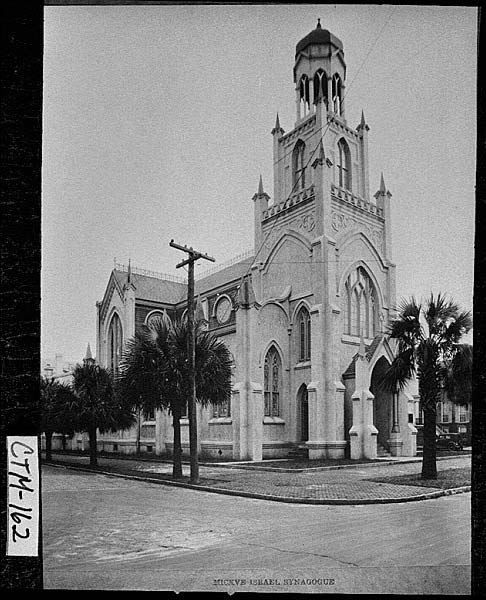
Courtesy of Georgia Archives.
The congregation continues to thrive in the midst of Savannah’s historic district and holds regular worship services. The nineteenth-century synagogue is listed on the National Register of Historic Places, and docents welcome tourists from around the world to see the Gothic sanctuary, with its original stained-glass windows and the congregation’s museum treasures.


